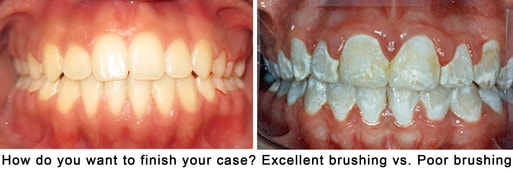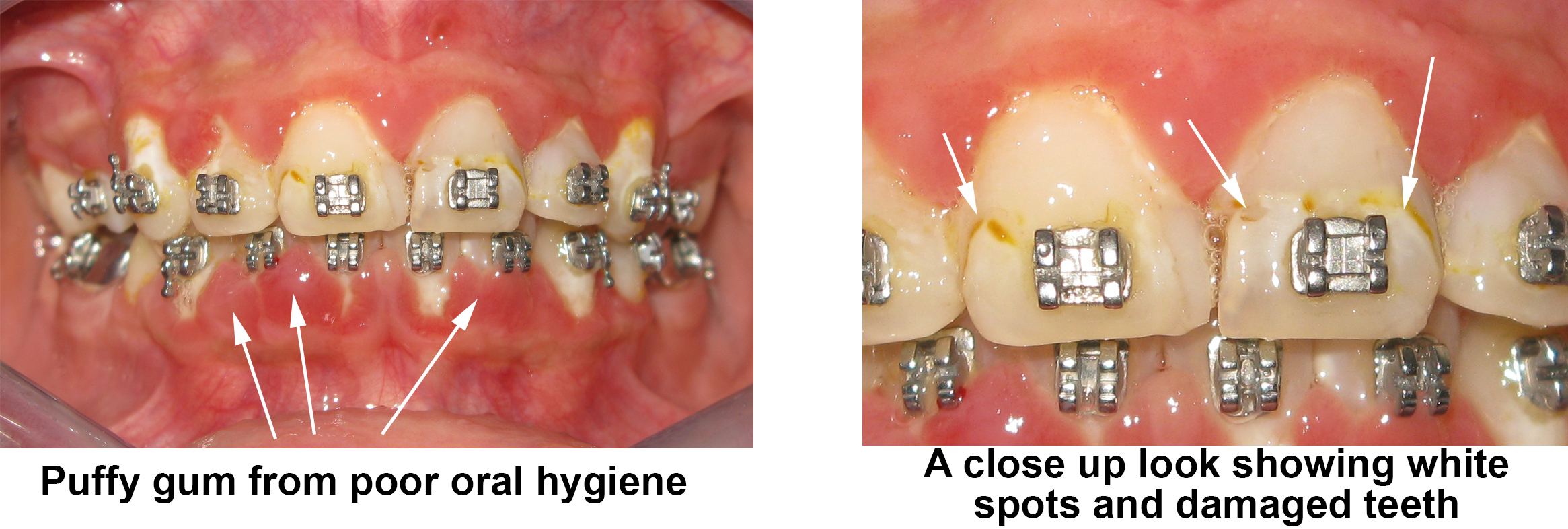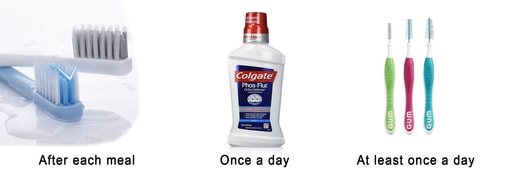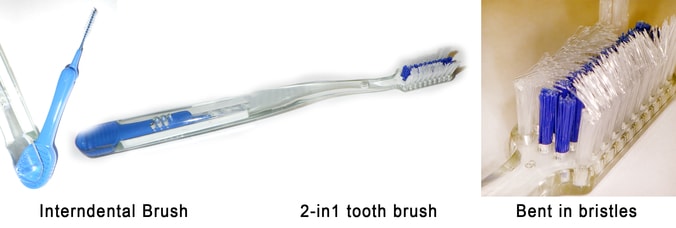How to Brush Your Teeth With Braces
Brushing and flossing your teeth properly while in braces is one of the important factors for a successful and beautiful outcome. Your brushing and oral hygiene will turn your treatment either into a fabulous smile or a disastrous one.

Why is it important to brush better with braces?
Generally, you need to brush your teeth at least twice a day. However, having braces makes it extremely important to brush, especially after each meal.
While in orthodontic treatment, different parts can act as food traps especially the braces wings, and hooks. Food will get stuck around braces and bacteria love to start feeding and growing in the food debris in the hidden areas.
The bacteria will survive on the trapped food and will start causing cavities and gum disease.
Children have weaker enamel than adults and this weak enamel is more susceptible to cavities. Thus, cavities will form faster and kids with poor oral hygiene will have more extensive damage compared to adults.
What happens when food is stuck around braces?
Within hours after eating, plaque will form on your teeth and around the braces. Harmful bacteria will start to grow in it. The bacterial plaque in your mouth will produce acid from the food left over your teeth. That acid will start slowly to eat away your enamel, taking weeks or even months to form a complete cavity around the area of the braces.

What is the first sign of having a cavity around my braces?
Unlike what the public thinks, pain is not the first sign of a cavity. A cavity will start as a white area that you cannot brush away which is called a white spot. The enamel of the white spot will start to deteriorate – or decalcify- under the acid attack produced by the bacteria. During the initial stages of decalcification, we can reverse the process by using certain kinds of toothpaste such as MI paste. This toothpaste has a unique ability to release calcium and phosphate back to tooth surfaces.
How to prevent cavities around braces?
- Occasional brushing is not enough. You need to brush perfectly to remove all the food around the braces at least three times a day using fluoride toothpaste. want it better? Brush after every meal and keep your teeth happy.
- Rinse your mouth once a day with a recommended anti-cavity fluoride rinse such as Colgate Phos-Flur® or ACT® Anticavity rinse. Both are Alcohol-free so you will not be worried about swallowing some leftovers. However, we prefer Colgate Phos-Flur as it has double the concentration of Sodium Flouride. Phos-Flur's concentration is 0.044% vs 0.02% for ACT Anti Cavity. Make sure you do not eat or drink for 30 minutes after rinsing and the best practice is to use it right before you go to bed.
- Visit your dentist every 6 months for cleaning and a complete oral health checkup.

How to brush with braces?
Whether you are using a manual toothbrush of your favorite color or an electrical one, you need to pay attention to the areas around the braces and under the wires to remove the food completely. For proper brushing, tilt the brush head at a 45-degree angle above and under the braces to clean the area perfectly. Flossing with braces is not easy if you don't use a floss threader.
So you will need to use an interdental brush to clean under the wire if the toothbrush is not enough. It is recommended also to use a magnified lighted mirror so you can see your teeth clearly while brushing to make sure nothing is left over.
Brush at a 45 degree angle & use the interndental brush to clean under the wire
Which toothbrush is the best to use with braces?
Because traditional flat toothbrushes have a hard time reaching all areas around braces, different companies innovated non-flat toothbrushes to clean better around the area of the braces.
- Oral-B, Gum, and Colgate all have an orthodontic toothbrush with a V-trim brush to facilitate cleaning around orthodontic appliances such as brackets, archwires, buttons, and ligatures.
- Amazon sells an orthodontic toothbrush with a V-Trim head and an interdental brush at the bottom so it is like a 2-in-1 toothbrush. You can also get the same one from dentalkit.com.
- IOS sells a unique orthodontic toothbrush that works like manic, the bristles are bent 45 degrees inward to clean under the brackets and the wire. There is also an interdental brush in the base of the handle.
- If you don’t have the skills and dexterity to brush perfectly, then an electric toothbrush is the answer to your problem. which one is better? Sonic-care and Oral-B? While it is a big argument, I am more inclined toward the Oral-B with the special orthodontic head.

What food to avoid with braces that cause cavities?
You should stay away from two major types of food and drinks: Sugary and Acidic.
Acidic drinks: research has shown that any drink with a pH < 4.0 can cause dental damage even in the absence of bacteria. Common drinks with a pH of less than 4.0 include lemon juice, Coca-Cola, Gatorade, Kool-aid, and more.
Sugary food: candies and sweets with caramelized sugar are very hard to clean around brackets as they stick hard. This includes Twix, Caramel, Milkyway, and more.
Can I brush my teeth on the first day of braces?
Absolutely YES. But your teeth might be sore for the first few days and brushing with a soft toothbrush is recommended. Make sure only the soft bristles touch the tooth surface, not the hard plastic handle as this might cause more pain on the sore teeth.
What happens if you don’t brush your teeth with braces?
- Of course, cavities. And,
- Your gum will get puffy and you might need to get surgery after braces to trim the extra gum. This procedure is called a gingivectomy and will cost you around $500. Also, puffy gums will cause you an extremely bad mouth smell. Be careful.
Do I have to brush the same way if I have Invisalign or other clear aligners?
While a lot of people believe that having Invisalign requires less oral hygiene, that is not correct. The Invisalign tray can act as a cooking pot for the sugar the leftover food to cause rampant decays, especially between the back teeth. The Invisalign tray will prevent the mechanical action of the tongue and saliva to clean between the teeth, making it an absolute to brush after each meal and before placing trays back into your mouth.

